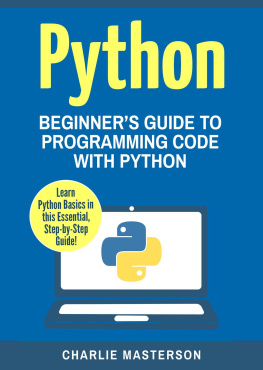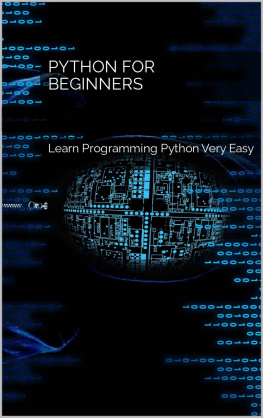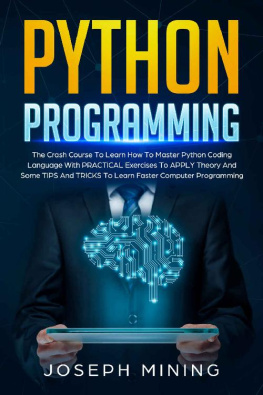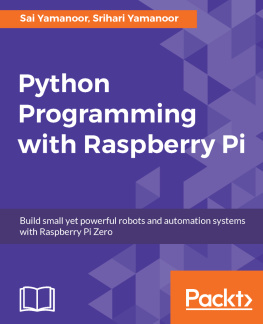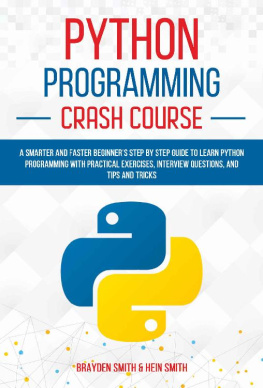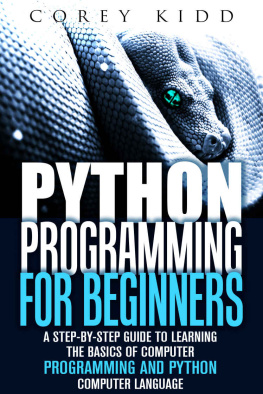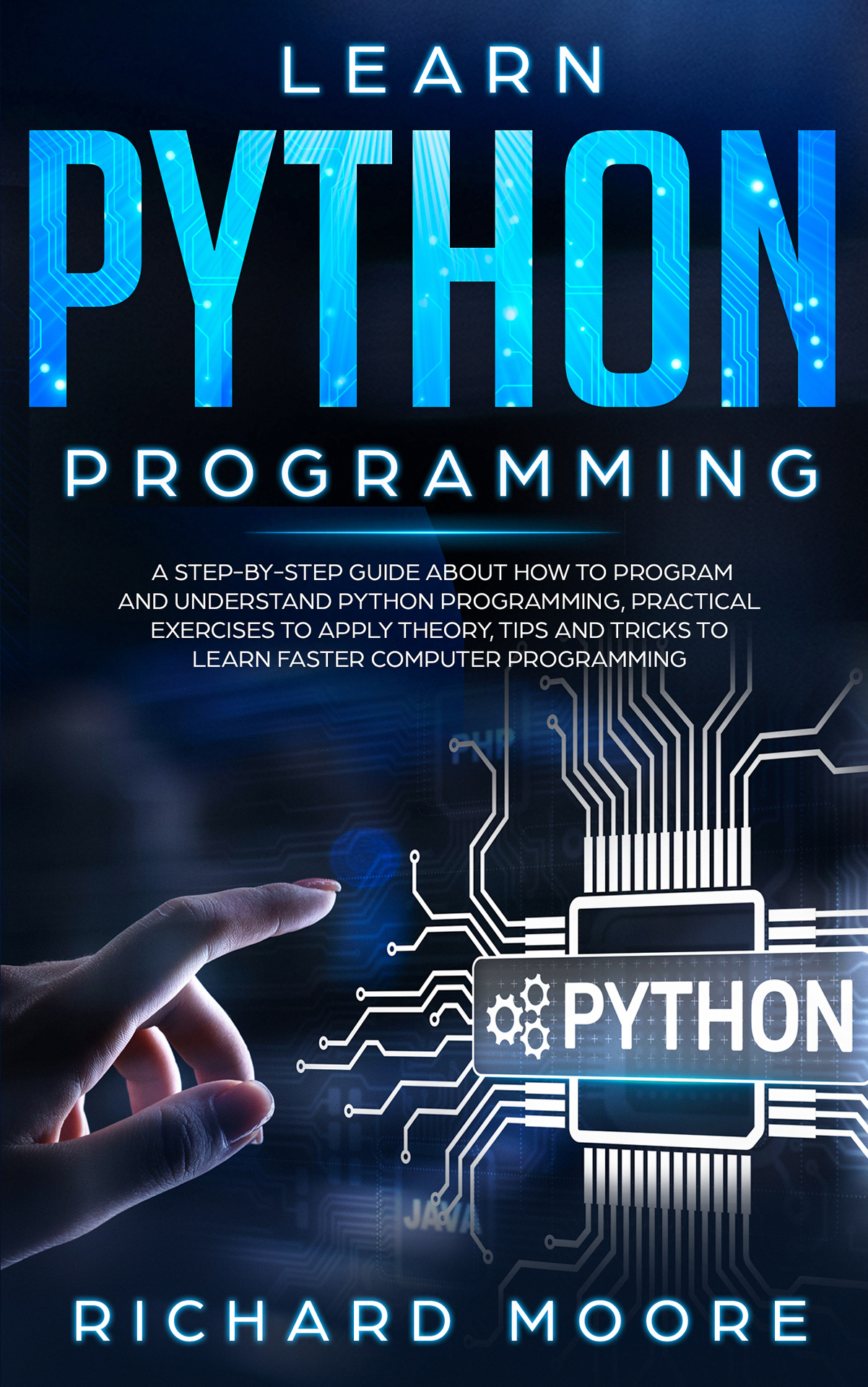Learn Python Programming
A Step-by-Step Guide about How to Program and Understand Python Programming, Practical Exercises to Apply Theory, Tips and Tricks to Learn Faster Computer Programming
By Richard Moore
Copyright 2019 - All rights reserved.
The content contained within this book may not be reproduced, duplicated or transmitted without direct written permission from the author or the publisher.
Under no circumstances will any blame or legal responsibility be held against the publisher, or author, for any damages, reparation, or monetary loss due to the information contained within this book, either directly or indirectly.
Legal Notice:
This book is copyright protected. It is only for personal use. You cannot amend, distribute, sell, use, quote or paraphrase any part, or the content within this book, without the consent of the author or publisher.
Disclaimer Notice:
Please note the information contained within this document is for educational and entertainment purposes only. All effort has been executed to present accurate, up to date, reliable, complete information. No warranties of any kind are declared or implied. Readers acknowledge that the author is not engaging in the rendering of legal, financial, medical or professional advice. The content within this book has been derived from various sources. Please consult a licensed professional before attempting any techniques outlined in this book.
By reading this document, the reader agrees that under no circumstances is the author responsible for any losses, direct or indirect, that are incurred as a result of the use of information contained within this document, including, but not limited to, errors, omissions, or inaccuracies.
Table of Contents
Introduction
Programming is on the verge of becoming a skill that everyone should have. It is almost the 21st century version of knowing how to read and write. You need it for web design, app and game design, machine learning, data mining, and even for the Internet of Things devices. What once used to be a skill that was taught in computer science classes at the university level is now taught starting from the first years of elementary school. However, its never too late to start learning, especially now with the widespread accessibility.
Getting started in programming is easy and it doesnt require much from you. All you need is a good guide, a computer and perhaps a few open source, community driven tools. You dont need to spend a single dime. All of this is especially true when it comes to the Python programming language.
Python is easily the most beginner-friendly and easy to learn programming language, and that is why most programmers start out with it. Building a solid foundation is crucial and it is easy to do so when you start properly without cutting any corners.
With the help of this book, Learn Python Programming , you will get the proper start you need. It will guide you through all the basic programming concepts and help you understand the software you need to work with. If you already have some programming experience with languages such as C++ or Java, you will notice a great deal of familiar concepts because they are universal to all programming languages. However, that doesnt mean you should skip on Python. Python is a powerful and versatile language, even though its simplistic and easy to grasp. So lets get you started on your journey and show you why Python is the right tool for every job.
Why Python?
Python was created in the early 90s by Guido van Rossum and since then it has grown into one of the most popular programming languages used in nearly all technical fields. If you arent familiar with the language, you might be wondering what a snake has to do with programming. Well, the creator had a sense of humor and a love for the Brittish comedy group Monty Python, so if youre a fan as well you will encounter quite a few references to them while reading the documentation.
Python gained almost immediate popularity as early as 1991 due to its basic syntax that resembles the English language. However, this simplicity doesnt mean that the language is strictly for beginners and it lacks the power to create complex software. On the contrary, as a programmer you can use Python for anything between writing a simple print statement to working with complex machine learning algorithms and neural networks.
The main reason why Python is recommended to every beginner even if theyre interested in eventually focusing on C++, is because it allows everyone to easily gain an understanding of the most important programming rules, concepts, and techniques. Once you know how to work in Python, you will easily transfer your knowledge to a variety of programming languages such as C++, C# or Java.
Another reason why Python is chosen even by veteran programmers and data scientists is because of how easy it is to extend the languages functionality. For instance, as a machine learner or data scientist you can install various modules and libraries that provide you with the tools you need in your field. Furthermore, there are a variety of tools that can help you maintain the program you create, even years in the future. Python is comparable to a Lego set. You can do nearly everything you want as long as you have the right components and some creativity.
With that being said, lets go through a number of specific reasons why Python is the ideal programming language and why you should invest time and energy into learning it over other languages.
Power: Beginners as well as professionals sometimes underestimate Python because they see it as a language to be used by students and without a future. They see it as something that teenagers work with, so they dont take it seriously. All of this couldnt be further from the truth. Python can be easily compared to powerful languages like C++. It is the language of choice in the field of data science and machine learning, and is even used by Google and NASA when working with artificial intelligence. There is no limit for Python, so dont listen to anyone who says that this language is weak and inefficient. Python can be used no matter what your interests are. You can even create high quality games with it.
User-friendly: We mentioned earlier that Python is chosen by most beginners because it is easy to comprehend even if you have very little theoretical knowledge about programming concepts and rules. Python is a high level programming language. In other words, it is nowhere near the machine language used by your computer which uses a low level language simply referred to as machine code. Pythons syntax follows the structure of the English language, which makes it very easy to read as well as write and then it is translated so that the computer system understands it as well. This feature allows you to write a great deal of code nearly as fast as you can write a normal sentence.
System compatibility: Python works no matter what hardware you use and what operating system you run. In addition, the system doesnt have to be a powerful one to get started with programming. A computer with less power than your phone can handle Python programming. The fact that the software you create doesnt depend on the operating system is one of the biggest advantages because you will often have to switch systems, especially when working with other people. Furthermore you will have to create independent tests to make sure your programs behave properly whether they run on Windows or Mac.
Adaptable programming language: Python doesnt actually limit you to Python alone. In fact you can write a program in C++, for instance, and then add some Python integration into it in order to use certain features that are available only in Python. Adaptability is important because you can combine the advantages of multiple programming languages in order to create a powerful and efficient application.



